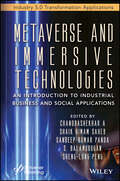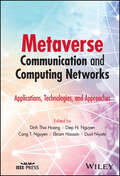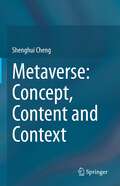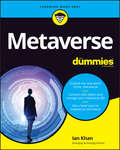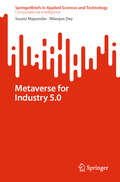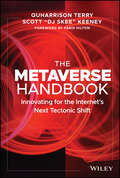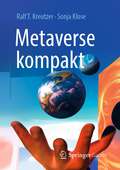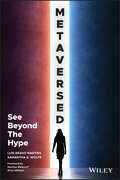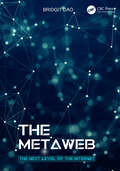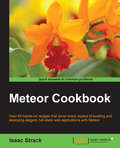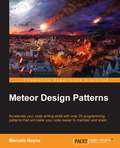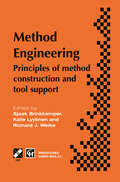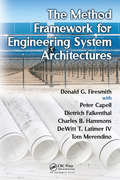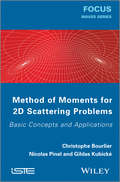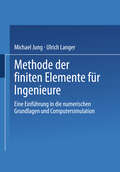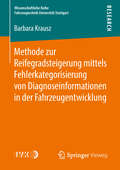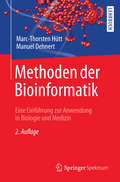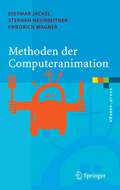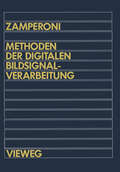- Table View
- List View
Metaverse and Immersive Technologies: An Introduction to Industrial, Business and Social Applications (Artificial Intelligence and Soft Computing for Industrial Transformation)
by Chandrashekhar A, Shaik Himam Saheb Sandeep Kumar Panda S. Balamurugan Sheng-Lung PengMETAVERSE AND IMMERSIVE TECHNOLOGIES The book covers the multidimensional perspectives of the metaverse through the prism of virtual reality, augmented reality, blockchain, artificial intelligence, and IoT, ranging from rudimentary to advanced applications. This book provides a thorough explanation of how the technology behind metaverse and other virtual reality technologies are changing the world. The primary objective is to present the revolutionary innovation of the 21st century—the metaverse—and exhibit its wide range of applications in different domains. Although blockchain and VR/AR were the first popularly known applications of the metaverse, several other applications also exist. While some still believe the metaverse is overhyped, in reality, it is transforming almost every industry—healthcare, 3D, 4D, industry, game industry, business management, artificial intelligence, and IoT, just to name a few. This technological breakthrough not only paved the way for virtual reality but also provided useful solutions for other areas of technology. The unique nature of the technology, which is a single, shared, immersive, persistent, 3D virtual space where humans experience life in ways not possible in the physical world, makes it suitable for all real-world applications; it has great potential to transform business, and companies are already in the race for different product offerings. Audience AI and computer science researchers, engineers and graduate students, IT personnel in business as well as entrepreneurs and policymakers.
Metaverse Communication and Computing Networks: Applications, Technologies, and Approaches
by Dinh Thai Hoang Diep N. Nguyen Cong T. Nguyen Ekram Hossain Dusit NiyatoMetaverse Communication and Computing Networks Understand the future of the Internet with this wide-ranging analysis “Metaverse” is the term for applications that allow users to assume digital avatars to interact with other humans and software functions in a three-dimensional virtual space. These applications and the spaces they create constitute an exciting and challenging new frontier in digital communication. Surmounting the technological and conceptual barriers to creating the Metaverse will require researchers and engineers familiar with its underlying theories and a wide range of technologies and techniques. Metaverse Communication and Computing Networks provides a comprehensive treatment of Metaverse theory and the technologies that can be brought to bear on this new pursuit. It begins by describing the Metaverse’s underlying architecture and infrastructure, physical and digital, before addressing how existing technologies are being adapted to its use. It concludes with an overview of the challenges facing the Metaverse. The result is a thorough introduction to a subject that may define the future of the internet. Metaverse Communication and Computing Networks readers will also find: Detailed treatment of technologies, including artificial intelligence, Virtual Reality, Extended Reality, and more Analysis of issues including data security, ethics, privacy, and social impact A real-world prototype for Metaverse applications Metaverse Communication and Computing Networks is a must-own for researchers and engineers looking to understand this growing area of technology, and entrepreneurs interested in establishing Metaverse businesses.
Metaverse Communication and Computing Networks: Applications, Technologies, and Approaches
by Dinh Thai Hoang Diep N. Nguyen Cong T. Nguyen Ekram Hossain Dusit NiyatoMetaverse Communication and Computing Networks Understand the future of the Internet with this wide-ranging analysis “Metaverse” is the term for applications that allow users to assume digital avatars to interact with other humans and software functions in a three-dimensional virtual space. These applications and the spaces they create constitute an exciting and challenging new frontier in digital communication. Surmounting the technological and conceptual barriers to creating the Metaverse will require researchers and engineers familiar with its underlying theories and a wide range of technologies and techniques. Metaverse Communication and Computing Networks provides a comprehensive treatment of Metaverse theory and the technologies that can be brought to bear on this new pursuit. It begins by describing the Metaverse’s underlying architecture and infrastructure, physical and digital, before addressing how existing technologies are being adapted to its use. It concludes with an overview of the challenges facing the Metaverse. The result is a thorough introduction to a subject that may define the future of the internet. Metaverse Communication and Computing Networks readers will also find: Detailed treatment of technologies, including artificial intelligence, Virtual Reality, Extended Reality, and more Analysis of issues including data security, ethics, privacy, and social impact A real-world prototype for Metaverse applications Metaverse Communication and Computing Networks is a must-own for researchers and engineers looking to understand this growing area of technology, and entrepreneurs interested in establishing Metaverse businesses.
Metaverse: Concept, Content and Context
by Shenghui ChengThe metaverse, a hybrid society of the real and the virtual is attracting significant attention from academia to industry and is starting to change the world. Composed of ten chapters, this book introduces the metaverse from three aspects – concept, content and context. It starts with numerous concepts related to the metaverse, such as virtual reality, augmented reality, Web 3.0 and NFTs and describes the background, features, advantages and disadvantages. It then presents the content or key techniques around the metaverse, Artificial Intelligence, big data, edge computing, 3D modeling and blockchain. For each technique, it depicts how it performs to advance the development of the metaverse. Finally, it gives the context of the metaverse and illustrates the new society in the virtual world, consisting of economic systems, assets, social activities, security, law, etcetera. Overall, Metaverse: Concept, Content and Context provides a panoramic view of the metaverse, a key feature of which is the intuitive visualizations with numerous figures that clearly address the main aspects. This book is well-designed and well-written and will appeal to beginners and students as well as professionals, welcome to the metaverse community!
Metaverse For Dummies
by Ian KhanYour first step to understanding what the metaverse is all about You've probably heard that the metaverse—a word that seemingly went from nonexistent to everywhere — is the next big thing in technology. What is it, anyway? Written by a leading futurist, Metaverse For Dummies unravels the mysteries of the metaverse, for the curious and for anyone looking to get in on the ground floor. Discover how to carve out your niche in the metaverse with easy-to-understand breakdowns of the major technologies and platforms, a guide to doing business in the metaverse, and explorations of what meta means for sports, education, and just about every other area of life. The book even gives you a guide to safety in the metaverse, including how much of your real life you should share in your virtual one. This book answers all the big questions about the metaverse, in simple terms. Explore the metaverse and the major players Get a look at how the metaverse will disrupt industries from gaming to online commerce Discover business opportunities on the metaverse Dive into metaverse gaming and virtual events—safely This book is a must for anyone looking for an approachable primer on what the metaverse is, how it works, and the opportunities within it.
Metaverse For Dummies
by Ian KhanYour first step to understanding what the metaverse is all about You've probably heard that the metaverse—a word that seemingly went from nonexistent to everywhere — is the next big thing in technology. What is it, anyway? Written by a leading futurist, Metaverse For Dummies unravels the mysteries of the metaverse, for the curious and for anyone looking to get in on the ground floor. Discover how to carve out your niche in the metaverse with easy-to-understand breakdowns of the major technologies and platforms, a guide to doing business in the metaverse, and explorations of what meta means for sports, education, and just about every other area of life. The book even gives you a guide to safety in the metaverse, including how much of your real life you should share in your virtual one. This book answers all the big questions about the metaverse, in simple terms. Explore the metaverse and the major players Get a look at how the metaverse will disrupt industries from gaming to online commerce Discover business opportunities on the metaverse Dive into metaverse gaming and virtual events—safely This book is a must for anyone looking for an approachable primer on what the metaverse is, how it works, and the opportunities within it.
Metaverse for Industry 5.0 (SpringerBriefs in Applied Sciences and Technology)
by Nilanjan Dey Soumi MajumderThis book provides a detailed picture of the metaverse for industry 5.0. In the context of Industry 5.0, the concept of the metaverse aligns with the vision of Web 4.0, representing a digital ecosystem where individuals and organizations collaborate in a human-centric approach to create personalized value.This virtual universe connects multiple interconnected worlds, enabling real-time interactions between users and computer-generated environments. By integrating technologies such as artificial intelligence (AI), virtual reality (VR), augmented reality (AR), mixed reality(MR) and the Internet of Things (IoT), the metaverse within Industry 5.0 aims to foster innovation and enhance productivity, efficiency, and overall well-being through tailored and value-driven solutions. This book explores the concept of the metaverse in the context of Industry 5.0, highlighting its definition, evolution, advantages, and disadvantages. It also discusses pillars of technological advancement, challenges, and opportunities, ethical issues including its integration into various sectors, i.e., healthcare, construction, manufacturing and others. The entry concludes with a proposal for a conceptual framework for integrating the human-centric metaverse.
The Metaverse Handbook: Innovating for the Internet's Next Tectonic Shift
by QuHarrison Terry Scott "DJ KeeneyThe metaverse is here. Are you ready? In The Metaverse Handbook: Innovating for the Internet's Next Tectonic Shift, a duo of experienced tech and culture experts delivers a can't-miss guide to participating in the most promising new technology since the advent of the web. Through dozens of metaverse creator case studies and concise, actionable insights, you'll walk away from this book understanding how to explore and implement the latest metaverse tech emerging from blockchain, XR, and web3. In The Metaverse Handbook, you'll discover: What the metaverse is, why you should care about it, and how to build your metaverse strategy The history of the metaverse and primers on critical technologies driving the metaverse, including non-fungible tokens, XR, the blockchain, and web3 How to unearth unique metaverse opportunities in digital communities, commerce, and immersive experiences As the metaverse has rapidly become the technology platform and marketing buzzword of the future, this new reality for companies, creators, and consumers is not easily understood at the surface level. Those who aim to be at the forefront of this exciting new arena must first understand the foundations and central technologies of the metaverse. An essential resource for digital professionals, creators, and business leaders in the vanguard of the coming technology revolution, The Metaverse Handbook provides the go-to roadmap for your journey into the metaverse.
The Metaverse Handbook: Innovating for the Internet's Next Tectonic Shift
by QuHarrison Terry Scott "DJ KeeneyThe metaverse is here. Are you ready? In The Metaverse Handbook: Innovating for the Internet's Next Tectonic Shift, a duo of experienced tech and culture experts delivers a can't-miss guide to participating in the most promising new technology since the advent of the web. Through dozens of metaverse creator case studies and concise, actionable insights, you'll walk away from this book understanding how to explore and implement the latest metaverse tech emerging from blockchain, XR, and web3. In The Metaverse Handbook, you'll discover: What the metaverse is, why you should care about it, and how to build your metaverse strategy The history of the metaverse and primers on critical technologies driving the metaverse, including non-fungible tokens, XR, the blockchain, and web3 How to unearth unique metaverse opportunities in digital communities, commerce, and immersive experiences As the metaverse has rapidly become the technology platform and marketing buzzword of the future, this new reality for companies, creators, and consumers is not easily understood at the surface level. Those who aim to be at the forefront of this exciting new arena must first understand the foundations and central technologies of the metaverse. An essential resource for digital professionals, creators, and business leaders in the vanguard of the coming technology revolution, The Metaverse Handbook provides the go-to roadmap for your journey into the metaverse.
Metaverse kompakt: Begriffe, Konzepte, Handlungsoptionen
by Ralf T. Kreutzer Sonja KloseDieses Buch ist ein erster Aufschlag, um die Auseinandersetzung mit dem Metaverse in Wissenschaft und Praxis voranzutreiben. Wie wird das Metaverse aussehen? Worum geht es? Wo stehen wir? Was benötigen wir? Wohin geht die Reise? Zunächst ist das Metaverse eine Idee bzw. ein Versprechen. Ralf T. Kreutzer und Sonja Klose versuchen, eine Vision greifbar und vorstellbar zu machen. Wie beim Internet ist es zu diesem Zeitpunkt schwierig vorherzusagen, welche Entwicklungen und Technologien von welchen Personen und Unternehmen in welcher Art und Weise erstellt und kombiniert werden.Die Autoren nehmen Sie an die Hand und empfehlen Ihnen: Ignorieren Sie diese Entwicklungen nicht! Es müssen nicht gleich umfassende Investitionen ins Metaverse getätigt werden. Aber ein paar Fingerübungen sind ratsam. Damit Sie schon an Bord sind, wenn der Zug tatsächlich Fahrt aufnimmt. Außerdem kann es Ihnen beim Employer Branding zu Vorteilen verhelfen, wenn sichtbar wird, dass Sie sich auch mit spannenden Zukunftsthemen beschäftigen.„Das vorliegende Werk zeigt einen spannenden, wissenschaftlich gut fundierten Blick auf das Metaverse.“ Dirk Lueth, Co-Founder von Upland und Mitverfasser des Werkes „Navigating the Metaverse“
Metaversed: See Beyond The Hype
by Samantha G. Wolfe Luis Bravo MartinsUnderstand the coming metaverse—and discover how to look past the hype and harness the future of technology. Metaversed is an insightful discussion and analysis of the next, rapidly approaching technological revolution. The authors deliver a compelling new exploration of how the metaverse and emerging technologies combine to define our collective future. In addition to identifying the business opportunities, the book pulls back the curtain on major safety and privacy issues that will arise and the expected shifts in both our private and social spheres. In the book, you’ll understand: How multiple industries will be changed and challenged in a 3D spatial world and how to navigate the future crypto-ladden business landscape; Legal and policy considerations necessary to build and maintain safe, shared digital spaces The economic and social impacts, including the potential for our digital lives to outlive our physical selves Actionable insights, so you can make the most out of the next digital revolution Metaversed is a can’t-miss presentation of the most significant market opportunities and societal challenges posed by the metaverse. It also will empower readers to take positive action that avoids the same online mistakes that happened on social media and create more responsible tech usage habits in our personal and professional lives.
Metaversed: See Beyond The Hype
by Samantha G. Wolfe Luis Bravo MartinsUnderstand the coming metaverse—and discover how to look past the hype and harness the future of technology. Metaversed is an insightful discussion and analysis of the next, rapidly approaching technological revolution. The authors deliver a compelling new exploration of how the metaverse and emerging technologies combine to define our collective future. In addition to identifying the business opportunities, the book pulls back the curtain on major safety and privacy issues that will arise and the expected shifts in both our private and social spheres. In the book, you’ll understand: How multiple industries will be changed and challenged in a 3D spatial world and how to navigate the future crypto-ladden business landscape; Legal and policy considerations necessary to build and maintain safe, shared digital spaces The economic and social impacts, including the potential for our digital lives to outlive our physical selves Actionable insights, so you can make the most out of the next digital revolution Metaversed is a can’t-miss presentation of the most significant market opportunities and societal challenges posed by the metaverse. It also will empower readers to take positive action that avoids the same online mistakes that happened on social media and create more responsible tech usage habits in our personal and professional lives.
The Metaweb: The Next Level of the Internet
by Bridgit DAOBuckle up for a fascinating journey through layers of insight and metaphors that explain the past, present, and future of the Web. Readers from all walks of life will learn something ancient, something novel, and something practical. Those who give it careful consideration will never see the Web the same way again. This book proclaims into existence decentralized public space above the webpage that enables the shift from personal to collective computing. The Web's next frontier is the Metaweb, a hyper-dimensional web over Today's Web that connects people and information silos, with accountability and fair value exchange. The Metaweb can drastically reduce false information, abuse, and scams, as well as enable the unprecedented level of collaboration needed to address humanity's global challenges. The book posits a symbiotic relationship between AI and the Metaweb, where AI assists in generating, organizing, and curating content, while the Metaweb provides the necessary constraints, data, and context for AI to function effectively, transparently, and in alignment with humanity. The AI-assisted collaboration among humans on the Metaweb will enable a vast collective intelligence and the capture of tremendous untapped value. For more information go to: http://metawebbook.com
The Metaweb: The Next Level of the Internet
by Bridgit DAOBuckle up for a fascinating journey through layers of insight and metaphors that explain the past, present, and future of the Web. Readers from all walks of life will learn something ancient, something novel, and something practical. Those who give it careful consideration will never see the Web the same way again. This book proclaims into existence decentralized public space above the webpage that enables the shift from personal to collective computing. The Web's next frontier is the Metaweb, a hyper-dimensional web over Today's Web that connects people and information silos, with accountability and fair value exchange. The Metaweb can drastically reduce false information, abuse, and scams, as well as enable the unprecedented level of collaboration needed to address humanity's global challenges. The book posits a symbiotic relationship between AI and the Metaweb, where AI assists in generating, organizing, and curating content, while the Metaweb provides the necessary constraints, data, and context for AI to function effectively, transparently, and in alignment with humanity. The AI-assisted collaboration among humans on the Metaweb will enable a vast collective intelligence and the capture of tremendous untapped value. For more information go to: http://metawebbook.com
Meteor Cookbook
by Isaac StrackThis book is meant for developers of all experience levels looking to create mobile and full-stack web applications in JavaScript. Many of the simple recipes can easily be followed by less-experienced developers, while some of the advanced recipes will require extensive knowledge of existing web, mobile, and server technologies. Any application or enterprise web developer looking to create full-stack JavaScript-based apps will benefit from the recipes and concepts covered in this book.
Meteor Design Patterns
by Marcelo ReynaAccelerate your code writing skills with over twenty programming patterns that will make your code easier to maintain and scale About This Book • Optimize your web application for production use • Build views and controllers with minimal effort that will evolve with your application • Learn how to maintain a MeteorJS project while it is running in production Who This Book Is For This book is for developers who have already had an introductory course with Meteor. Basic knowledge of web development is recommended. What You Will Learn • Use of Jade, Stylus, and CoffeeScript to speed up web development • Increase productivity by leveraging the best packages in the community • Optimize your site for load speed with advanced publishers and subscribers • Leverage the aggregation framework to produce results with big data • Master the intricacies of front-end development using Jeet, Bootstrap, CSS animations, and more • Optimize your site for search engine visibility • Secure your site with Meteor's best practices • Track the live status of your application, ensuring all errors have been taken care of In Detail With the increasing interest in NodeJS web applications, a new framework, Meteor, has joined the ranks to simplify developer workflows. Meteor is one of the few open source frameworks that has received funding since its early development stages. It builds on ideas from existing frameworks and libraries, offering developers an easy way to develop a prototype app. At the same time, it gives them the tools and flexibility to build a fully fledged production app. Meteor is the weapon of choice for start-ups in today's world. Meteor Design Patterns cuts through the jargon that most websites play with and gets to the point with simple solutions that will boost your development skills. We start off with a refresher on the basics of JavaScript programming such as templates, CoffeeScript, the Event Loop, and the Merge Box, amongst others. You then learn how to map real-world data and optimize the data's publishers to output data with the least amount of work done by the server with some subscribe and publish patterns. Next, using front-end patterns, you will learn how to create maintainable and trackable forms, and make our site crawlable by any search engine. Following this, you will see how to optimize and secure the web application and maintain applications without breaking other features. Finally, you will learn how to deploy a secure production-ready application while learning to set up modulus, compose with Oplog tracking and SSL certificates, as well as error tracking with Kadira. Throughout the book, you will put your skills to practice and build an online shop from scratch. By the end of the book, you will have built a feature-rich online shop. Style and approach The book is a practical handbook on how to build an e-commerce web app using Meteor. Every topic ties into the webapp to easily illustrate the concepts that you are learning about.
Method Engineering: Principles of method construction and tool support (IFIP Advances in Information and Communication Technology #244)
by Sjaak Brinkkemper Kalle Lyytinen Richard WelkeThe Method Framework for Engineering System Architectures
by Donald G. Firesmith Peter Capell Dietrich Falkenthal Charles B. Hammons DeWitt T. Latimer IV Tom MerendinoThe architects of today's large and complex systems all too often struggle with the lack of a consistent set of principles and practices that adequately address the entire breadth of systems architecture. The Method Framework for Engineering System Architectures (MFESA) enables system architects and process engineers to create methods for effective
Method of Moments for 2D Scattering Problems: Basic Concepts and Applications
by Christophe Bourlier Nicolas Pinel Gildas KubickéElectromagnetic wave scattering from randomly rough surfaces in the presence of scatterers is an active, interdisciplinary area of research with myriad practical applications in fields such as optics, acoustics, geoscience and remote sensing. In this book, the Method of Moments (MoM) is applied to compute the field scattered by scatterers such as canonical objects (cylinder or plate) or a randomly rough surface, and also by an object above or below a random rough surface. Since the problem is considered to be 2D, the integral equations (IEs) are scalar and only the TE (transverse electric) and TM (transverse magnetic) polarizations are addressed (no cross-polarizations occur). In Chapter 1, the MoM is applied to convert the IEs into a linear system, while Chapter 2 compares the MoM with the exact solution of the field scattered by a cylinder in free space, and with the Physical Optics (PO) approximation for the scattering from a plate in free space. Chapter 3 presents numerical results, obtained from the MoM, of the coherent and incoherent intensities scattered by a random rough surface and an object below a random rough surface. The final chapter presents the same results as in Chapter 3, but for an object above a random rough surface. In these last two chapters, the coupling between the two scatterers is also studied in detail by inverting the impedance matrix by blocks. Contents 1. Integral Equations for a Single Scatterer: Method of Moments and Rough Surfaces. 2. Validation of the Method of Moments for a Single Scatterer. 3. Scattering from Two Illuminated Scatterers. 4. Scattering from Two Scatterers Where Only One is Illuminated. Appendix. Matlab Codes. About the Authors Christophe Bourlier works at the IETR (Institut d’Electronique et de Télécommunications de Rennes) laboratory at Polytech Nantes (University of Nantes, France) as well as being a Researcher at the French National Center for Scientific Research (CNRS) on electromagnetic wave scattering from rough surfaces and objects for remote sensing applications and radar signatures. He is the author of more than 160 journal articles and conference papers. Nicolas Pinel is currently working as a Research Engineer at the IETR laboratory at Polytech Nantes and is about to join Alyotech Technologies in Rennes, France. His research interests are in the areas of radar and optical remote sensing, scattering and propagation. In particular, he works on asymptotic methods of electromagnetic wave scattering from random rough surfaces and layers. Gildas Kubické is in charge of the “Expertise in electroMagnetism and Computation” (EMC) laboratory at the DGA (Direction Générale de l’Armement), French Ministry of Defense, where he works in the field of radar signatures and electromagnetic stealth. His research interests include electromagnetic scattering and radar cross-section modeling.
Method of Moments for 2D Scattering Problems: Basic Concepts and Applications
by Christophe Bourlier Nicolas Pinel Gildas KubickéElectromagnetic wave scattering from randomly rough surfaces in the presence of scatterers is an active, interdisciplinary area of research with myriad practical applications in fields such as optics, acoustics, geoscience and remote sensing. In this book, the Method of Moments (MoM) is applied to compute the field scattered by scatterers such as canonical objects (cylinder or plate) or a randomly rough surface, and also by an object above or below a random rough surface. Since the problem is considered to be 2D, the integral equations (IEs) are scalar and only the TE (transverse electric) and TM (transverse magnetic) polarizations are addressed (no cross-polarizations occur). In Chapter 1, the MoM is applied to convert the IEs into a linear system, while Chapter 2 compares the MoM with the exact solution of the field scattered by a cylinder in free space, and with the Physical Optics (PO) approximation for the scattering from a plate in free space. Chapter 3 presents numerical results, obtained from the MoM, of the coherent and incoherent intensities scattered by a random rough surface and an object below a random rough surface. The final chapter presents the same results as in Chapter 3, but for an object above a random rough surface. In these last two chapters, the coupling between the two scatterers is also studied in detail by inverting the impedance matrix by blocks. Contents 1. Integral Equations for a Single Scatterer: Method of Moments and Rough Surfaces. 2. Validation of the Method of Moments for a Single Scatterer. 3. Scattering from Two Illuminated Scatterers. 4. Scattering from Two Scatterers Where Only One is Illuminated. Appendix. Matlab Codes. About the Authors Christophe Bourlier works at the IETR (Institut d’Electronique et de Télécommunications de Rennes) laboratory at Polytech Nantes (University of Nantes, France) as well as being a Researcher at the French National Center for Scientific Research (CNRS) on electromagnetic wave scattering from rough surfaces and objects for remote sensing applications and radar signatures. He is the author of more than 160 journal articles and conference papers. Nicolas Pinel is currently working as a Research Engineer at the IETR laboratory at Polytech Nantes and is about to join Alyotech Technologies in Rennes, France. His research interests are in the areas of radar and optical remote sensing, scattering and propagation. In particular, he works on asymptotic methods of electromagnetic wave scattering from random rough surfaces and layers. Gildas Kubické is in charge of the “Expertise in electroMagnetism and Computation” (EMC) laboratory at the DGA (Direction Générale de l’Armement), French Ministry of Defense, where he works in the field of radar signatures and electromagnetic stealth. His research interests include electromagnetic scattering and radar cross-section modeling.
Methode der finiten Elemente für Ingenieure: Eine Einführung in die numerischen Grundlagen und Computersimulation
by Michael Jung Ulrich LangerDieses Buch wird es Ihnen ermöglichen, technische Probleme mit Differentialgleichungen zu modellieren und die FEM-Software zu ihrer Computersimulation zu erstellen. Gleichzeitig soll es Ihnen das Verständnis für die zugrunde liegenden numerischen Techniken erschliessen.
Methode zur Reifegradsteigerung mittels Fehlerkategorisierung von Diagnoseinformationen in der Fahrzeugentwicklung (Wissenschaftliche Reihe Fahrzeugtechnik Universität Stuttgart)
by Barbara KrauszBarbara Krausz stellt eine Methode vor, mit welcher der Reifegrad in der Fahrzeugentwicklung mittels Fehlerkategorisierung von Diagnoseinformationen gesteigert werden kann. Dazu ordnet sie gelöste Fehlerfälle bzw. Fehlerspeichereinträge zuvor definierten Ursachenkategorien zu. Die Kategorien wählt die Autorin hierbei so, dass eine Unterscheidung zwischen entwicklungsspezifischen und serienrelevanten Ursachen möglich ist. Sie trainiert einen geeigneten Klassifikator mit den gelösten Trainingsfällen und ordnet die Fälle anhand der Ähnlichkeit der Fehlerumgebungsdaten den entsprechenden Ursachenkategorien zu. Mit dieser Methode wird die Fehleranalyse in der Fahrzeugentwicklung beschleunigt und der Reifegrad der Diagnose bereits vor dem SOP (Start of Production) erhöht.Die AutorinBarbara Krausz ist bei einem großen deutschen Automobilhersteller als Entwicklungsingenieurin in der Powertrain-Entwicklung für PKW tätig. Sie promovierte am Institut für Verbrennungsmotoren und Kraftfahrwesen (IVK) der Universität Stuttgart.
Methoden der Bioinformatik: Eine Einführung zur Anwendung in Biologie und Medizin
by Marc-Thorsten Hütt Manuel DehnertSchritt für Schritt zu den KonzeptenDie Autoren führen den Leser von den mathematischen Grundlagen zu den konkreten Methoden der Bioinformatik. Das Buch wendet sich damit an alle, die bioinformatische Methoden und Softwarepakete verwenden wollen, sie aber nicht als Black Boxes akzeptieren möchten.Ein besonderes Highlight ist die schrittweise Implementierung wichtiger Algorithmen der Bioinformatik im Computeralgebra-Programm Mathematica, um die Konzepte auch auf der informatischen Ebene zu verstehen. Das Themenspektrum reicht von bioinformatischen Alltagsfragen bis in die Systembiologie. Die zweite, stark erweiterte Auflage geht auch auf eine Reihe sehr aktueller Themen der Bioinformatik ein, etwa Next-Generation Sequencing (NGS), GWAS-Daten und Protein-Interaktions-Netzwerke.Der Inhalt ist spannend und leicht verständlich.
Methoden der Computeranimation (eXamen.press)
by Dietmar Jackèl Stephan Neunreither Friedrich WagnerDas Buch richtet sich an eine Leserschaft, die bereits Grundkenntnisse in der Computergrafik hat. Vorwiegend ist hierbei an Studenten der Informatik gedacht, die bereits eine Computeranimationsvorlesung belegt haben oder die ein vertieftes Interesse an diesem Gebiet besitzen. Neben einem Überblick über die relevanten Themen der Computeranimation wurde ein besonderes Schwergewicht auf die physikalisch-basierten Animationsmethoden gelegt. Zum einfacheren Verständnis, speziell der physikalisch-basierten Methoden, sind allerdings Grundkenntnisse in der Physik sowie in der Analysis sehr hilfreich. Das Buch zeichnet sich im Besonderen dadurch aus, dass es auch exemplarisch wichtige Details einiger Animationsmethoden behandelt, die deren Implementierungen erleichtern.
